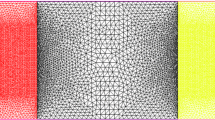Abstract
This paper deals with the analysis of the internal control of a parabolic PDE with nonlinear diffusion, nonlocal in space. In our main result, we prove the local exact controllability to the trajectories with distributed controls, locally supported in space. The main ingredients of the proof are a compactness–uniqueness argument and Kakutani’s fixed-point theorem in a suitable functional setting. Some possible extensions and open problems concerning other nonlocal systems are presented.
Similar content being viewed by others
References
Alekseev VM, Tikhomorov VM, Formin SV (1987) Optimal control. Consultants Bureau, New York
Chang NH, Chipot M (2003) On some model diffusion problems with a nonlocal lower order term. Chin Ann Math 24(B:2):147–166
Chang NH, Chipot M (2003) Nonlinear nonlocal evolution problems. Rev R Acad Cien Serie A Mat (RACSAM) 97(3):393–415
Clark HR, Fernández-Cara E, Limaco J, Medeiros LA (2013) Theoretical and numerical local null controllability for a parabolic system with local and nonlocal nonlinearities. Appl Math Comput 223:483–505
Fabre C, Puel JP, Zuazua E (1995) Approximate controllability of the semilinear heat equation. Proc R Soc Edinb Sect 125A:31–61
Fernández-Cara E, Lü Q, Zuazua E (2016) Null controllability of linear heat and wave equations with nonlocal spatial terms. SIAM J Control Optim 54(4):2009–2019
Fernández-Cara E, Zuazua E (2000) Null and approximate controllability for weakly blowing up semilinear heat equations. Ann Inst Henri Poincaré Anal Non linéaire 17(5):583–616
Fernández-Cara E, Zuazua E (2000) The cost of approximate controllability for heat equations: the linear case. Adv Differ Equ 5:465–514
Fursikov AV, Imanuvilov OY (1996) Controllability of evolution equations. Lecture notes series, vol 34. Seoul National University, Research Institute of Mathematics, Global Analysis Research Center, Seoul
Imanuvilov OY, Yamamoto M (2003) Carleman inequalities for parabolic equations in Sobolev spaces of negative order and exact controllability for semilinear parabolic equations. Publ Res Inst Math Sci 39(2):227–274
Imanuvilov OY (1995) Controllability of parabolic equations. Sb Math 186(6):879–900
Ladyzhenskaya OA, Solonnikov VA, Ural’ceva NN (1968) Linear and quasilinear equations of parabolic type. Translations of mathematical monographs, vol 23. AMS, Providence
Liu Xu, Zhang Xu (2012) Local controllability of multidimensional quasi-linear parabolic equations. SIAM J Control Optim 50(4):2046–2064
Author information
Authors and Affiliations
Corresponding author
Additional information
Publisher's Note
Springer Nature remains neutral with regard to jurisdictional claims in published maps and institutional affiliations.
Partially supported by MINECO (Spain), Grant MTM2016-76990-P.
Appendix: proof of Lemma 2.2
Appendix: proof of Lemma 2.2
Let \(w \in Z\) be given, and let us set
Let us assume that \(\varphi \) satisfies
From the standard Carleman estimates for \(\varphi \), one has
where \(C_0\) only depends on \(\Omega \), \(\omega \), T, \(a_0\), \(a_1\). M and \(\Vert w\Vert _{Z}\) and \(\tilde{C}_0\) only depends on \(\Omega \), \(\omega \), \(a_0\), \(a_1\), M and \(\Vert w\Vert _{Z}\); see [7, 9]. Taking into account that
and
we see from (5.1) that
and consequently,
The asymptotic behavior of the integrals in the left hand side is well known. Indeed, one has
(see, for instance, [8]). Thus, there exists \(\tilde{C}_1\), again depending on \(\Omega \), \(\omega \), \(a_0\), \(a_1\), M and \(\Vert w\Vert _{Z}\), such that
Obviously, this leads to (2.1) and ends the proof.
Rights and permissions
About this article
Cite this article
Fernández-Cara, E., Límaco, J., Nina-Huaman, D. et al. Exact controllability to the trajectories for parabolic PDEs with nonlocal nonlinearities. Math. Control Signals Syst. 31, 415–431 (2019). https://doi.org/10.1007/s00498-019-00244-9
Received:
Accepted:
Published:
Issue Date:
DOI: https://doi.org/10.1007/s00498-019-00244-9



